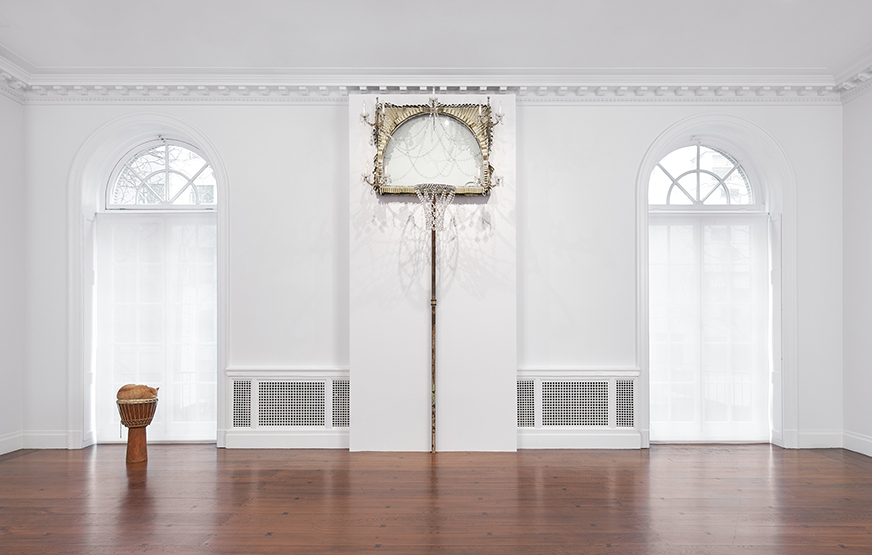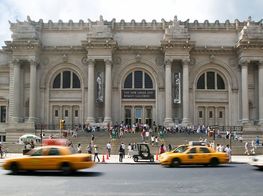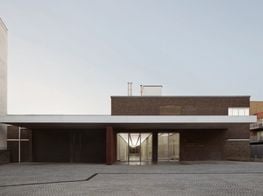Exhibitions in New York to see in May

Mnuchin Gallery
David Hammons: Five Decades
15 March - 27 May, 2016
David Hammons is an artist with no shortage of press covering his prolific career. Yet, it’s no secret that he prefers to remain out of the spotlight, often declining interviews and not attending his own openings, keeping the art world pomp and circumstance largely at bay. This seemingly serves to add to the mystique of his personality but also to accentuate the sense of integrity that pervades his practice. Hammons' current show at Mnuchin Gallery, David Hammons: Five Decades, is an intelligent presentation of works organised in close collaboration with the enigmatic artist.The show at Mnuchin is a small scale career survey, the first since MoMA PS1’s Rousing the Rubble 1969-1990 (16 December 1990 to 10 February 1991), and - including sculpture, painting, and personal photographs - reveals the diversity of his work from the late 60s until now. Reflecting upon his career one is able to see the artist’s exceptional ability to accurately and cleverly opine on issues of race and class.
He precisely dissects these issues with wit and consistent commentary on the state of both the art world and those outside and inside of it, often directly engaging the public in the process of doing so. In 1983 Hammon’s Bliz-aard Ball Sale, a performance piece in which he sold varying snowballs of different shapes and sizes in downtown Manhattan, showcased his ability to comment satirically both on his own art as a commodity, as well as issues of race.

Perhaps the strongest work in the exhibition, and one which resonates with the current political landscape, is In the Hood, a work Hammons completed in 1993. It consists of a detached section of a hooded sweatshirt, referencing a symbol that has become synonymous with both the Black Lives Matter movement and also the right-wing media rhetoric, where the ‘hoodie’ was used as an outrageous means to justify the shooting of teenager, Trayvon Martin. The work is hung on the back wall of the gallery like a sort of prize, visible upon entry to the exhibition.
Hammons has been praised by collectors and critics alike, and the art market also continues to be enamoured with his work. In a 2002 interview with the New Yorker, Peter Schjeldahl said of the artist that ‘nothing in contemporary art matches his poetic compound of modesty, truculence, and wit’. This wit is injected thoughout the exhibition, and one of the works, a small untitled sculpture displays this perfectly. A small rock resembles a human head and is covered in hair Hammons collected from a Harlem barbershop, drawing on metaphors relating to self-identification while reflecting the artist’s Arte Povera influences. This work has already been removed to be presented in an upcoming sale at Christie’s in May, with a rather hefty estimate. Another work, Basketball Chandelier, features a basketball hoop adorned with a crystal net and a decorative backboard of ornate glass. A comment on the belief that professional sports is the path to opportunity and success for young black boys to escape an impoverished lifestyle.
Hammons is often given the task of being ‘the voice of black contemporary art’. However, it seems that he simply strives to represent that which often is under-represented in blue-chip art galleries. His goal is not to represent the whole of black America, but simply to bring attention to the facets of our society that interest him, not only in relation to socio-politics, but also in relation to the rarified art world that he very comfortably occupies. David Hammons is a master of his craft. Ever-changing and evolving, his work remains substantive.

Michael Werner Gallery
Allen Jones: A Retrospective
31 March – 4 June, 2016
Allen Jones, the British pop artist, is best known for his figural depictions of women. His current show, on view at Michael Werner Gallery and organised by Sir Norman Rosenthal, is the first of its kind to be exhibited in New York. The Royal Academy in London having had a retrospective of the artist’s work in 2014. His New York show features paintings and sculptures in his signature bright pop colors and an interplay between formalist and abstracted ideas. Though the exhibition is brief, it offers an overview by including works from 1969-2015.The artist's most noted works, Hatstand, Table, and Chair, a group of three sculptures that present life-size images of women as furniture, were first exhibited in 1970 at the Institute of Contemporary Arts, London. The works were met with angry protests from feminists who believed the sculptures to be sexist. These life-like female figures more closely resembled erotic mannequins, rather than fine art sculptures. They were shown topless and leather-clad in varying positions. Their manipulated stances corresponded with the titles of the work and alluded to their more ‘functional purpose’. Jones’ imagery again came under fire in 2014 when Dasha Zhukova, the mega-collector and Garage Contemporary Art Foundation founder, was photographed for a feature that appeared in Buro 24/7 (an online fashion publication) sitting on a Bjarne Melgaard chair inspired by these same Allen Jones sculptures. However, unlike Jones' work, Melgaard’s chair featured a black woman, triggering accusations of sexism and racism, but nonetheless echoing the protests that occurred in the 1970’s.
While Hatstand, Table, and Chair are not featured in this exhibition, they are certainly the seminal works connected with Allen Jones and his oeuvre. Yet, Rosenthal and Michael Werner Gallery do a great job of drawing attention to other aspects of Jones’ practice. Included in the exhibition are two works prominently featuring the female form, Treasure Chest and Curious Woman. The artificial quality of the painted plastics and the three dimensionality of the canvases is quintessentially pop, but done in a more spirited and cheeky manner in comparison to many of his counterparts, such as Wesselman and Rosenquist, whose imagery we know so well. Another work, Jones' large painting Cascade features undulating oranges, red, and yellow brushstrokes that produce bold washes of colour.
One cannot help but to think of Toulouse-Lautrec when looking at the painting, Stand In completed by Jones in 1991, which depicts two images of a woman. A two-dimensional female body is splashed with pink, blue, green, and yellow above a sign that reads ‘silence’. There’s also a three-dimensional fiberglass body covered in red and yellow paint, in a servile stance that seems to embody the duality of Jones work: subject matter with a seemingly dark undertone covered in a signature cheery saturated color palette. Rosenthal very accurately declares, ‘What gives Allen Jones his uniqueness is an extraordinary and very personal painting technique that he has refined over many decades. It is smooth, even silky, in the way he applies color gradients totally at one with the fetishistic aspect of the subject matter’.
Certainly the figures in Jones’ work do appear to fall into the great body of work over the centuries depicting the female figure as the subject of the male gaze. However, in Jones’ splashy paintings the women he depicts appear commanding, powerful and exude a sense of sexual freedom and power over the viewer. Nonetheless, there is a danger of a monolithic interpretation of Jones' representation of women. The artist insists that this is not his intention. Yet one can’t help but think of the hyper-sexualised undercurrent that accompanies these images, even in their playfulness and beauty. This bifurcation of ideas seems to be a defining quality of Allen Jones' work; one that is important to understanding why this artist has deserved his place in the art historical canon.
Rosenthal concludes that ‘The beauty of art, and by implication life, is the multiple readings it affords’. This exhibition is exciting because Allen Jones' work certainly conforms to this notion. Jones' work is thought provoking in its translation of feminist ideas and sexual power and also in its display of the Freudian implications of sexual desire. In doing so, Jones' work is accessible on multiple levels, forcing viewers to consider ideas of objectification and voyeurism to make their own conclusions. Ultimately it could be argued, it represents subversiveness that still provokes today.
The Metropolitan Museum of Art
Cornelia Parker
Transitional Object (Psycho Barn)
19 April – 31 October, 2016
British artist, Cornelia Parker, has been commissioned for The Metropolitan Museum of Art’s fourth annual Iris and Gerald B. Cantor Roof Garden Commission. Well-known for her transformation of recognisable objects into large scale installations, Parker has been selected to transform the outdoor space overlooking the Museum’s incredible urban vista.For the commission, Parker has installed a replica of a large Victorian home atop the Met’s rooftop. She originally hoped to install a red barn, but quickly discovered barns were much too large for Manhattan rooftops (even at the Met). Upon further research, Parker was further influenced by Edward Hopper, specifically his painting, House by the Railroad, from 1925, featuring a Victorian mansion, which was also the inspiration for the home of Norman Bates in the Alfred Hitchcock film Psycho.
Parker recalled that initially she wanted to create something that was not in competition with the New York skyline, rather, something that worked to complement it. While the idea of placing a barn on a rooftop proved to be too great of a feat, she worked with a restoration company to create her own iteration of the barn. As a result, Transitional Object (PsychoBarn) on the Met rooftop is made of corrugated metal and the siding from the reclaimed wood of a barn from upstate New York assembled by set designers and carpenters. This toys with the notion of this wholesome, hardworking, American image, as it was artificially composed, produced, and designed.
With her further investigation into the project, Parker discovered that the home on the Hitchcock movie set was only filmed from two angles. As a result, Parker designed the PsychoBarn in the same manner. Viewing the barn at the Met - depending upon your angle - you are either in perfect view of a country home with all of Manhattan as its back yard, or in perfect view of the metal supports and scaffolds holding up the front facade of the reproduction. Thus it presents you with an interesting framework for examination.
Edward Hopper frequently painted scenes that depicted psychological dislocation in modern life using distance as a metaphor. Parker’s reconstructed home also creates a clear delineation set against the Manhattan cityscape, while her manufactured barn presents ideas of wholesome country life - but only from afar. Transitional (PsychoBarn) juxtaposes such varying perspectives and in doing so challenges the beliefs that we hold about familiar cliches and connotations associated with domestic life, city-life and the use of false facades that are at the forefront in this intelligent work. —[O]















































































































































































